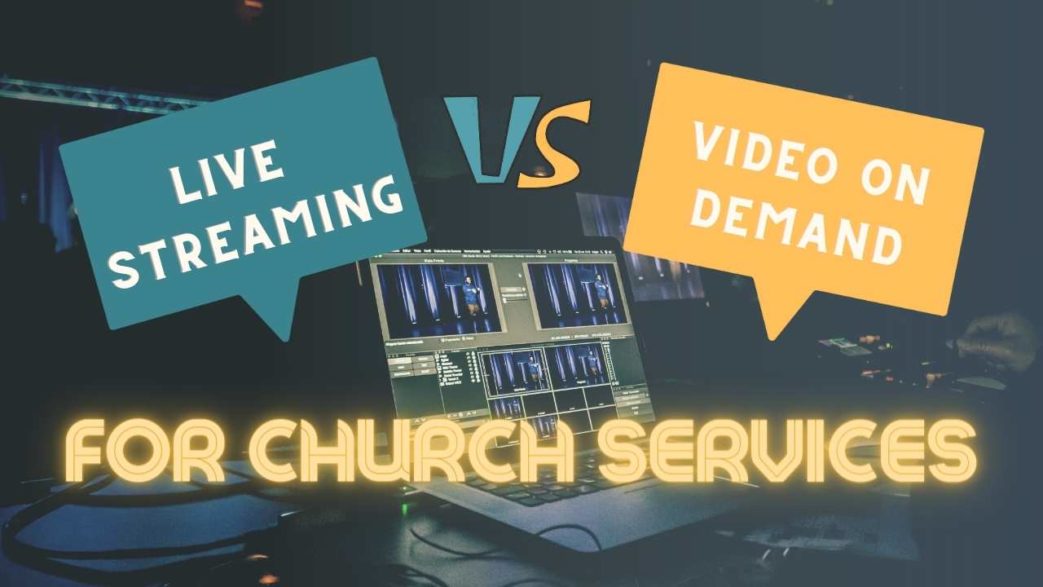Estimated reading time: 10 minutes
You probably already know that your members and church website visitors love getting to see your services online, but do they prefer live streaming or video on demand.
The way you offer online services makes a big difference in engagement. When it comes to live streaming vs. video on demand for church services, each has their own unique benefits.
The key is understanding those differences, how they affect your church and how they affect engagement. There isn’t a right or wrong option as long as your viewers are happy.
Table of contents
- Main Purpose Of Live Streaming
- Benefits Of Video On Demand
- Where Live Streaming Falls Short
- Common Issues With Video On Demand
- Understanding What Your Viewers Want
- Offering A Combination Approach
- Reasons To Live Stream Without An On Demand Option
- Reasons For Video On Demand Without Live Streaming
- What’s Best For Your Church

Main Purpose Of Live Streaming
Obviously thanks to COVID-19, more churches than ever before embraced live streaming. While the reason behind the increase is something we’d all love to forget about, it did introduce many churches to the benefits of live streaming. In fact, many plan to continue offering this as an alternative to in-person services.
And that is the main purpose of this option. You’re offering a live alternative for members who can’t attend in person. You’re also helping to increase engagement and fellowship for those who only join you online. By watching live, people online feel more connected since they’re experiencing everything at the same time as your in-church visitors. It’s a unique worship experience that feels more like the real thing, even though nothing can truly replace in-person worship.
Depending on the live streaming setup, you’re able to directly address those viewing from home. Unlike simply watching a video later, people are more likely to pay attention when you’re addressing them in a live stream.
Surprisingly, many churches actually noticed an increase in attendance when using live streaming at the start of the pandemic. While numbers vary now, people appreciated the convenience. They got to sleep a little later, yet still attend services live. Thanks to continuing to offer live services, worshipers’ faith actually grew during 2020. This proves that live streaming has the power to reach people and how nurture their faith.
Benefits Of Video On Demand
While live streaming definitely has its perks, don’t discount video on demand. In fact, long before live streaming was feasible for most churches, video on demand was already increasing in popularity. Instead of viewing services when they happen, you upload the service after it’s over and post it online. It’s the same service, just available an hour or two after it’s finished. This gives you time to edit, if necessary, and upload it.
You’re free to host your videos on your church website, social media, YouTube or any video hosting site that’s appropriate for your church. This allows you to make them widely available, reaching a large audience.
In some ways, you actually have the potential to reach even more people with video on demand. Often, people can’t attend live services due to their job or other equally important obligations. So, even if you only offer live streaming, they won’t be able to attend. With video on demand, they’re able to attend whenever it’s convenient for them.
For anyone that can’t attend during normal hours, this provides the perfect compromise. They might not be worshipping at the same time as their fellow church members, but they’re still able to worship. Plus, they’re able to talk about the service with their friends later.
Another benefit you might not think about initially is this option is usually easier and cheaper. Yes, you still need to buy the right equipment to film high-quality, engaging video. But, you don’t have to think about bandwidth or finding the right live streaming platform. In fact, you can host for free on YouTube and simply embed the video on your site. This is a great budget-friendly approach.
One final benefit is members are able to go back and review your sermons. Many people enjoy listening to a rousing sermon again. Others want to go back and listen to a part they missed. Whether it’s a few hours or even a few weeks later, people are able to pick the sermon they want and watch all over again.

Where Live Streaming Falls Short
As you might have noticed, video on demand has a major advantage over live streaming – it’s available any time. Whether it’s the same day as the live service or several days later, people are able to watch the service. No one feels rushed trying to watch the service live. This is ideal for those who aren’t feeling well, are traveling out of town or are at work.
Live streaming also doesn’t give you a chance to make changes once you start filming. With video on demand, you can go back and make some minor edits, such as increasing the volume or brightening a darker video. You’re also at the mercy of the Internet. If something goes down during your services or you get more viewers than expected, you’ll have to deal with complaints from people who tuned in only to see a blank screen, slow loading or buffering video, latency problems and other related issues. For new website visitors tuning in for the first time, this makes a bad first impression. This is also a good reason to ensure your church website is making a good first impression too.
Another way live streaming falls a little short is the need for a live streaming platform. These usually come with a monthly fee and can vary based on the number of viewers or bandwidth.
However, those fees are definitely worth it if live streaming is helping you grow your church and overall engagement. Church Production’s guide to live streaming ROI helps you better see how to measure the effectiveness of this approach.
On the other hand, your church can use a platform like Facebook Live that’s free. This is a great alternative to other platforms. Plus, there are a variety of metrics to track engagement to see how well live streaming is working for your church.
Common Issues With Video On Demand
Of course, video on demand isn’t perfect either. The most obvious downside is people aren’t able to worship live with everyone else. This can decrease the connection and engagement factor for some viewers. For others, they’re just grateful for the chance to watch services from their favorite church.
You also have to consider the cost of hosting videos. Higher-quality videos aren’t small, especially when they’re anywhere from 45 minutes to over an hour. Some web hosts do offer unlimited storage, while others charge extra. For limited storage, you’ll have to make the decision on how long to keep your videos up. Some churches keep an archive of all their services to make it easy for anyone to view them at anytime.
If you’re hosting on a free platform like YouTube, you can avoid this issue. However, some viewers might think it’s odd for a church to put their services on YouTube versus their own church website. With smaller churches, most viewers understand. Of course, a YouTube approach can attract organic views too. You might even choose to upload them to Facebook instead. Just make sure that the audience you’re targeting uses Facebook. Facebook requires an account while YouTube doesn’t.
Understanding What Your Viewers Want
The single most important thing is understanding what your viewers want most. Talk with your members about how they prefer watching services when they can’t attend in person. Also, ask them why they’re not attending. If it’s because they’re not home, live streaming likely isn’t the best approach. Video on demand works better in this instance.
However, if it’s because they’ve moved and are a little further from church and don’t always get ready on time, live streaming is a great option. In this case, your viewers still want to worship during the normal time, but circumstances tend to make them late to in-person services.
If you have an active social media following, ask your followers what they’d prefer. Do they want to worship all at the same time or later at a time that’s more convenient? Also, ask them where they’d prefer watching services.
All of this helps you create the right strategy. After all, you want to pick the option that works best for the majority of viewers.

Offering A Combination Approach
The ideal option is to offer a combination approach. This gives your church the best of both worlds. Start with live streaming and then upload that for video on demand viewing. Those who want to worship live can do so while those who can’t attend at that exact time are able to view whenever they want.
There’s a reason why Facebook Live gives you the option to show your video as a standard video post after the live streaming event is over. People aren’t always able to attend, no matter how much they might want to. It’s a great way to increase engagement, viewers and overall reach.
Since you’re already filming the live stream, it’s not difficult to keep the video. If you’re trying to entice new visitors to your church, having a few video on demand services on your site gives them a good idea of what to expect when they visit in person.
Reasons To Live Stream Without An On Demand Option
Some churches are completely against anything except in-person services. However, some have compromised and offer live streaming. In this instance, the reason to only offer live streaming is to encourage viewers to attend in person. These churches sometimes feel that video on demand makes it too convenient to just stay home.
There are other reasons to live stream without offering the video to view later. Usually, this involves special events versus you main services. You might live stream a concert or play. You may have a Q&A session with members. While you could offer these for viewing later, you may choose to make them more special by live streaming them only.
If you’re on a budget, you might stick just with live streaming versus trying to host videos yourself. This is especially true if your web host has strict storage and bandwidth limits. Of course, if you’re just more comfortable with live streaming, that’s always a good reason too.

Reasons For Video On Demand Without Live Streaming
A common reason churches opt for video on demand without offering live streaming is budget. It’s easy to get started with simply recording and uploading versus trying to get everything set up to live stream. Plus, when you’re live streaming, there’s also the expectation to engage with your viewers through chat throughout the service, which isn’t always easy to do.
There’s also the fact that video on demand tends to reach a larger audience since it’s available anytime. You can bypass web host limitations by limiting how many videos you host at a time.
One more reason that might not be as obvious is the pastor might not be comfortable with a live audience at home. While it might not seem any different than preaching in church, knowing there are people watching that you can’t see definitely has the potential to make you nervous. Simply filming and then uploading takes those nerves away.
You might also choose to do video on demand for special resources. These could be guides for helping kids understanding difficult Bible concepts, someone reading Bible stories or anything else helpful for your members and site visitors.
What’s Best For Your Church
As we said before, there isn’t a right or wrong way to do this. The most effective option is usually offering both live streaming and video on demand. However, do what’s best for your church.
Take the time to listen to both online and offline feedback to see what people prefer. Also pay attention to engagement metrics. Check to see how many people tune in to your live stream and how long they stay. If they’re only staying a few minutes, live streaming might not be worth it. Check how many unique views your on demand videos get. Once again, if the number is too low, this option might not be working.
Obviously, if the metrics show that one or both are increasing online engagement, then you have your answer. What works best for your members, including online followers, is what works best for your church.
No matter which option you offer, you’ll still want an engaging church website to showcase your videos. Contact us today to see how we can help create the perfect site for your visitors.




